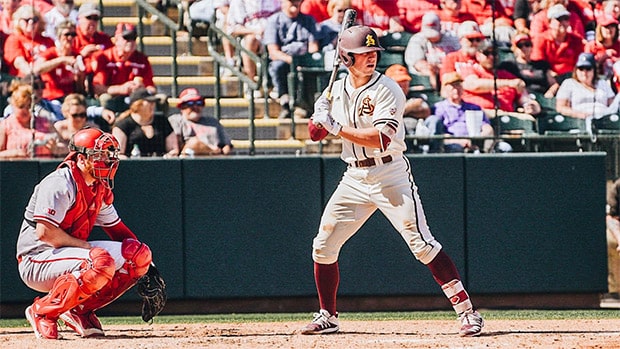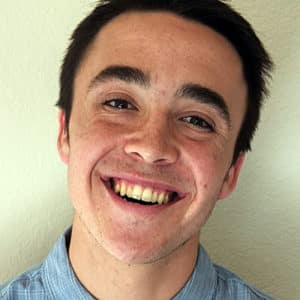
Arizona State Athletics
The first round of the 2020 MLB Draft was full of special moments and surprising picks.
Fireworks started at No. 2 overall and continued throughout the night with plenty of buzz and excitement. This year’s draft class was touted for its college arms and prep talent, and it lived up to the bill.
Four more rounds remain, but here are some key takeaways and observations from the first round.
Heston Kjerstad goes No. 2 overall
The first surprise of the draft was Arkansas outfielder Heston Kjerstad jumping Vanderbilt’s Austin Martin and the top college arms at No. 2 overall to the Baltimore Orioles. Kjerstad was rumored to be a late riser among draft boards, but him being drafted second overall was quite a surprise.
Kjerstad is one of the elite power bats in the draft. He has a heavy left-handed swing with a big hand circle within his load and low leg kick that generates plenty of pop. The 6-foot-3 outfielder has power at the plate, but he can become an established hitter at the next level, as he’s shown to slash extra base-hits to the opposite field throughout his college career. He’s also beat the shift and settled for opposite field dribblers down the third base line.
The Orioles went under-slot at the No. 2 selection with Kjerstad, they spent the 30th pick in Competitive Balance Round A on Mississippi State shortstop Jordan Westburg. Regardless, Kjerstad’s name wasn’t expected at that spot.
Max Meyer is the first arm off the board
Texas A&M lefty Asa Lacy was viewed as the consensus top pitcher in the class, but Minnesota right-hander Max Meyer was the first arm selected third overall to the Miami Marlins.
Despite his 6-foot frame, Meyer’s stuff speaks for itself. His fastball consistently sits between 94-97 mph with a slight rising action in the zone. Meyer arguably has the best slider in the draft, it comes in at 87-91 with a sharp break to both sides of the plate.
The draft started off with back-to-back surprise picks, and Meyer is an immediate impact to the Marlins’ tantalizing farm system.
Zac Veen’s sweet swing lands in Colorado
Independence High School outfielder Robert Hassell was the first prep player off the board, but Spruce Creek outfielder Zac Veen may have fell to the perfect situation with the Colorado Rockies at No. 9 overall.
Veen was looked at as the premier prep player of the class with excellent bat speed and power for an 18-year-old. He can add more bulk to his 6-foot-4 frame to make him a dangerous threat in the box. His strengths at the plate can be an enticing combination with the thin air at Coors Field.
Veen’s name was listed as high as No. 4 to the Royals, but a slight slip can be the best case scenario for him and the Rockies.
Giants select catcher Patrick Bailey
San Francisco selected Georgia Tech catcher Joey Bart second overall in 2018. This year, it played the talent on the board and took North Carolina State backstop Patrick Bailey 13th overall. While the fit is peculiar, Bailey has the tools to be an impact player in the big leagues.
At the plate, Bailey is a switch-hitter with solid raw power and contact. His sharp eye in the box translates to a good amount of walks. Defensively, Bailey’s athleticism shines brightest with a springy pop time and strong arm to throw out opposing base stealers.
If Bart and Bailey both make it to the Major Leagues, one of them may have to move to first base or fill the universal designated hitter, if possible. Bailey profiles as the more traditional catcher with less offensive potential. Bart’s powerful bat is one of his best tools and he may offer more defensive versatility.
Either way, the Giants may have a weird, but intriguing situation on their hands.
Nick Yorke catapults into the first round
The most surprising pick of the night may be by the Boston Red Sox, who selected Archbishop Mitty prep infielder Nick Yorke 17th overall.
Yorke ranked as the No. 96 overall prospect by Baseball America and was MLB Pipeline’s No. 139 prospect on the board. Despite the low draft status, Yorke has some solid tools across the board. He has a pure right-handed swing and offers defensive versatility around the diamond.
Boston is rebuilding its farm system, Yorke can be a prospect to grow and develop.
Jared Kelley slips to Day 2
Refiguo right-hander Jared Kelley was among the top prep arms with Mick Abel and Nick Bitsko. Abel was picked 15th by the Phillies and Bitsko was selected 24th by the Rays, but Kelley fell out of the first round.
Kelley does come with some risk as a prep arm in a loaded draft, but he’s shown flashes of a dominant three-pitch mix highlighted by a fastball in the 93-96 mph range that has reached 98 mph. His changeup is another effective offering with a distinct fade against lefties.
It will be interesting to see who scoops up Kelley, he may test the college waters and commit to Texas due to his drop in the draft.
Heartwarming: Prep shortstop Ed Howard stays home
Mount Carmel shortstop Ed Howard is often viewed as the best prep infielder in the draft, and he found a “home” with the Chicago Cubs at No. 16 overall.
Howard played high school ball in Illinois and was a member of the Jackie Robinson West All-Star team that won the United States championship at the 2014 Little League World Series.
Along with his unique background, Howard is more than just a heartwarming story. The 6-foot-2 shortstop has a simple right-handed approach at the plate that makes consistent contact. His baseball IQ and smooth hand-to-glove transfers shows he’s projectable to stay at shortstop.
Howard’s tools and intangibles makes him a tantalizing prospect within the Cubs’ farm system.
Up Next: More excitement will continue as the 2020 MLB Draft heads into rounds two through five tomorrow at 2 p.m. Pacific on the MLB Network and ESPN.
— Isaiah Burrows

